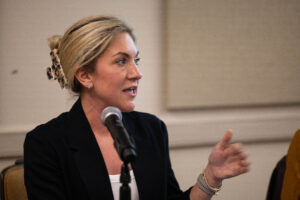April 16, 2024 | Business Models, ISOJ2024, Local Journalism
Strategies to improve revenue of local news media and projects are subject of discussion at 25th ISOJ
Lee este artículo en español abajo
View video from this workshop here
If there is one topic that journalists should talk more about, it is money. That is why on the first day of the 25th International Symposium on Online Journalism (ISOJ), the lunch hour was used to talk about strategies to optimize revenue in local media.
Courtney Lewis, chief of growth programs at the Institute for Nonprofit News (INN); Michael Ouimette, chief investment officer of the American Journalism Project; and Katie Rethman, product strategy lead for Newspack at Automattic, each had a space to talk about their projects that benefit local journalism.

Rethman started the panel by talking about how the media will be increasingly dependent on first party data (all the information or data sources organizations have about their clients) and how Newspack can help local media in the collection of this data.
Newspack is a division of Automattic (the commercial arm of WordPress) and was founded in March 2019 to provide an affordable publishing and monetization platform for small and medium-sized independent local news publishers.
According to Rethman, with the use of Newspack, local independent media can have first-party data in a single place and not be disaggregated between different third-party platforms, such as platforms for newsletter creation, donation management, membership programs, etc.
Having all the data in one place would allow media to create personalized calls to action based on what is known about a user, thus improving customer relationships.
The second presentation was given by Lewis from INN who discussed lessons learned about nonprofit news organizations.
“One of the things that we’ve seen in the new nonprofit sector, particularly amongst local newsrooms, is that they have a sort of outside share of earned revenue compared to nonprofits that cover a statewide audience or cover the nation or the globe,” Lewis said. That means, in local media, advertising and sponsorship still play a relevant role.
Lewis emphasized that the use of sponsored content in local non-profit media, a situation that did not occur years ago, was increasingly being seen.
The way media in the sector are doing this is by adapting certain rules such as: creating sponsored content policies, reviewing and editing content pieces with the right to reject if a publishing agreement is not reached, hiring freelancers to write the pieces, and not leaving that job to the media outlet’s reporters and including the option in packages with other offers.
“Another trend we see in the nonprofit news sector is individual giving, particularly in local. It is a smaller share than you might see with other larger or national news organizations, but it’s still growing pretty quickly,” Lewis added.
Lewis ended her presentation by emphasizing the importance of creating strategies to retain those small individual donors (who give less than $1,000) and to move them to the next level by converting them into medium-sized donors (between $1,000 – $5,000).
Ouimette, the last speaker, began by explaining what the American Journalism Project consists of, which is being responsible for granting subsidies to nonprofit news organizations. They also partner with communities to launch new organizations and train leaders as they grow and sustain their newsrooms.

“In general, our overall approach to our program is that we are grantmakers that make investments typically of about $1 million, over three years, to fund revenue-generating roles that can help organizations diversify their revenue,” Ouimette said.
He also showed success stories in revenue diversification such as that of Sahan Journal, in Minnesota; Block Club Chicago, and Cityside in California. The latter has achieved an outstanding balance between all its sources of income: earned revenue, individual donations, foundations and memberships.
For media interested in applying for American Journalism Project grants, “we have a submission form on our site. So if you are a local nonprofit newsroom, and by local we mean serving local audiences with coverage about their communities, you can go and fill out the form,” Ouimette said.
The workshop ended with feedback from attendees and a debate about the importance of continuing to talk about money and optimizing revenue in the media.
“People are uncomfortable asking for money, and journalists are notoriously uncomfortable asking people for money and asking for help. Those are the things that do become barriers,” Lewis concluded.
ISOJ is a global online journalism conference organized by the Knight Center for Journalism in the Americas at the University of Texas at Austin. In 2024, it is celebrating 25 years of bringing together journalists, media executives and scholars to discuss the impact of the digital revolution on journalism.
Estrategias para mejorar ingresos de medios de comunicación y proyectos de periodismo local son objeto de debate en el 25º ISOJ
Si hay un tema del que los periodistas deberían hablar más es sobre dinero. Es por ello que en el primer día del 25 aniversario del Simposio Internacional de Periodismo Online (ISOJ) se aprovechó el espacio del almuerzo para hablar sobre estrategias para optimizar los ingresos en los medios locales.
Courtney Lewis, jefa de programas de crecimiento del Institute for Nonprofit News (INN); Michael Ouimette, director de inversiones del American Journalism Project y Katie Rethman, jefa de estrategia de producto de Newspack en Automattic tuvieron cada uno un espacio para hablar de los proyectos que llevan en marcha que benefician al periodismo local.
Rethman dio inicio al panel hablando sobre cómo los medios serán cada vez más dependientes de los first party data o datos de primera fuente (toda aquella información o fuente de datos que poseen las organizaciones de sus clientes) y cómo Newspack puede ayudar a los medios locales en la recolección de estos datos.
Newspack es una división de Automattic (el brazo comercial de WordPress) y se fundó en marzo de 2019 con el objetivo de proporcionar una plataforma de publicación y monetización asequible para pequeños y medianos editores de noticias locales independientes.
Según comentó Rethman, con el uso de Newspack los medios independientes locales pueden tener los first party data en un solo lugar y no desagregados entre distintas plataformas de terceros, como por ejemplo en plataformas para la creación de newsletter, manejo de donaciones, programas de miembros, etc.
Tener todos los datos en un solo lugar permitiría a los medios crear llamadas a la acción personalizadas basadas en lo que se sabe sobre un usuario y mejorar así las relaciones con los clientes.
La segunda presentación estuvo a cargo de Lewis del INN quien conversó sobre las lecciones aprendidas sobre organizaciones de noticias sin fines de lucro.
“Una de las cosas que hemos visto en el nuevo sector sin fines de lucro, particularmente entre las redacciones locales, es que tienen una especie de participación externa en los ingresos obtenidos en comparación con las organizaciones sin fines de lucro que cubren una audiencia estatal o cubren la nación o el mundo”, dijo Lewis. Es decir, en los medios locales la publicidad y el patrocinio aún tienen un rol relevante.
Lewis hizo hincapie en que cada vez se estaba viendo más el uso del contenido patrocinado en medios locales sin fines de lucro, una situación que años atrás no ocurría.
La manera en la que los medios del sector lo están haciendo es adaptando ciertas reglas como: creando políticas de contenido patrocinado, revisando y editando las piezas de contenido con derecho a rechazar si no se llega a un acuerdo de publicación, contratando a freelancers para escribir las piezas y no dejarle ese trabajo a los reporteros del medio, e incluir la opción en paquetes con otras ofertas.
“Otra tendencia que vemos en las organizaciones del sector de noticias sin fines de lucro es donaciones individuales, particularmente en el ámbito local. Es una proporción menor de la que se podría ver en otras organizaciones de noticias más grandes o nacionales, pero aún está creciendo bastante rápido”, agregó Lewis.
Lewis finalizó su presentación enfatizando la importancia de crear estrategias para retener a esos pequeños donantes individuales (que donan menos de mil dólares) y pasarlos a un siguiente nivel convirtiéndolos en donantes medios (entre mil y cinco mil dólares).
Por su parte, Ouimette, el último ponente, comenzó su intervención explicando en que consiste el American Journalism Project que se encarga otorgar subvenciones a organizaciones de noticias sin fines de lucro. También se asocian con comunidades para lanzar nuevas organizaciones y capacitan a líderes a medida que crecen y sostienen sus redacciones.
“En general, el enfoque de nuestro programa es que damos subvenciones, inversiones típicamente de alrededor de un millón de dólares, durante tres años, para financiar roles generadores de ganancias que pueden ayudar a las organizaciones a diversificar sus ingresos”, explicó Ouimette.
Además mostró casos de éxitos en la diversificación de ingresos como el de Sahan Journal, en Minnesota; Block Club Chicago y Cityside en California. Esta última ha logrado un destacado balance entre todas sus fuentes de ingreso: ganancias obtenidas, donaciones individuales, fundaciones y membresías.
Para los medios interesados en aplicar a las subvenciones del American Journalism Project “tenemos un formulario de envío en nuestro sitio. Entonces, si usted es una redacción local sin fines de lucro, y por local nos referimos a servir a audiencias locales con cobertura sobre sus comunidades, puede ir y completar el formulario”, dijo Ouimette.
El taller finalizó con la retroalimentación de los asistentes y conversando sobre la importancia de seguir hablando sobre dinero y la optimización de ingresos en los medios.
“La gente se siente incómoda pidiendo dinero y, los periodistas se sienten notoriamente incómodos pidiendo dinero a la gente y pidiendo ayuda. Esas son las cosas que se convierten en barreras”, concluyó Lewis.
ISOJ es una conferencia mundial de periodismo online organizada por el Centro Knight para el Periodismo en las Américas de la Universidad de Texas en Austin. En 2024, celebra 25 años reuniendo a periodistas, ejecutivos de medios y académicos para debatir sobre el impacto de la revolución digital en el periodismo.

